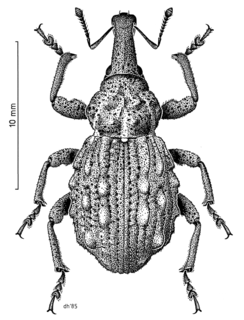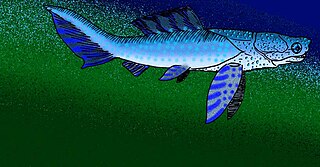
The New Zealand long-tailed bat, also known as the long-tailed wattled bat or pekapeka-tou-roa (Māori), is one of 15 species of bats in the genus Chalinolobus variously known as "pied bats", "wattled bats" or "long-tailed bats". It is one of the two surviving bat species endemic to New Zealand, but is closely related to five other wattled or lobe-lipped bats in Australia and elsewhere.

Hadramphus tuberculatus is a rare weevil endemic to Canterbury in the South Island of New Zealand. It was thought to be extinct in 1922 but was rediscovered in 2004.
Veigaiidae is a family of mites belonging to the superorder Parasitiformes. However they are not parasitic but free-living and predatory and are found in soil and decaying organic matter. Some species are specialists of rocky shorelines. Members of this family can be distinguished by a hyaline appendage on the tarsus of the pedipalp.
Gamasolaelaps bellingeri is a species of mite belonging to the family Veigaiidae. The female is only 0.5 mm in length, the male even smaller. Both can be recognized by the dorsal sclerotized shield being deeply incised laterally. This species is found in damp habitats such as moss and leaf litter in Jamaica.
Rhacophorus tuberculatus is a species of frog in the family Rhacophoridae found in eastern and northeastern India and southeastern Tibet, China. It is known from tropical moist forests and bamboo forests. Breeding has been observed from bushes near to small forest ponds. It may hide in bamboo stems during the day. The species is threatened by habitat loss.

Vanderhaege's toad-headed turtle is a species of turtle in the family Chelidae. The species is endemic to South America.

The Vanikoro flying fox, also known locally as basapine, is a species of bat in the family Pteropodidae. It has only been found in the Vanikoro island group located in the southern Solomon Islands. The species as a whole was originally known from just a few specimens collected sometime before 1930 but following surveys conducted on the island in the early 1990s did not detect this species again causing the Vanikoro flying fox to be listed as extinct. However, the species was rediscovered by a survey conducted in late 2014 which indicated a population in the high hundreds or low thousands and reported all observations.

Retodus is an extinct genus of prehistoric lungfish found in Cretaceous-aged freshwater strata of Egypt, Algeria and Niger. The type species, R. tuberculatus, was named in 2006. It was originally named as a species of Ceratodus and Neoceratodus in 1963.
Gamasolaelaps arborescens is a species of mite in the family Veigaiidae.
Gamasolaelaps aurantiacus is a species of mite in the family Veigaiidae.
Gamasolaelaps bidentis is a species of mite in the family Veigaiidae.
Gamasolaelaps excisus is a species of mite in the family Veigaiidae.
Gamasolaelaps multidentatus is a species of mite in the family Veigaiidae.
Gamasolaelaps pygmaeus is a species of mite in the family Veigaiidae.
Gamasolaelaps whartoni is a species of mite in the family Veigaiidae.

Simosteus tuberculatus is a small arthrodire placoderm from the Gogo Formation of Western Australia. Unlike other members of the arthrodire family Camuropiscidae, S. tuberculatus had a short, snub-nose, as directly implied by the translation of its generic name, "snub-nosed bone." Although S. tuberculatus lacks the characteristic elongated nose, it shares other diagnostic features of camuropiscids, such as cheekplates sutured to the cranium.

Rhinosteus is a genus of small to medium selenosteid arthrodire placoderms known from the Upper Frasnian Kellwasserkalk facies of Late Devonian Germany and Morocco.

Helodermoides is an extinct genus of anguid lizards from the Oligocene of North America. The genus is monotypic, including only the species Helodermoides tuberculatus. Helodermoides belongs to an extinct subfamily of anguids called Glyptosaurinae. In addition to many fragmentary bones, several complete skeletons of Helodermoides are known. Like other glyptosaurines, Helodermoides was covered in small scale-like bones called osteoderms. The osteoderms covering its skull are hexagonal, tightly interlocking, raised, and rounded.
Pseudarmadillo tuberculatus is an extinct species of isopod in the family Delatorreiidae known from a series of possibly Miocene fossils found on Hispaniola. At the time of description P. tuberculatus was one of two Pseudarmadillo species known from the fossil record and one of only two from Hispaniola.
Oroperipatus tuberculatus is a species of velvet worm in the Peripatidae family. The type locality is in Colombia.







